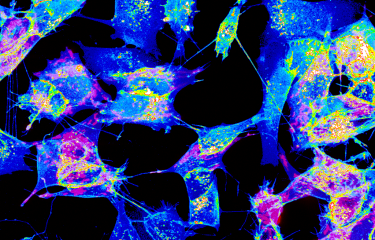Alzheimer's and Parkinson's diseases are the most widespread forms of neurodegeneration in humans. Each year, 225,000 new cases of Alzheimer's disease are diagnosed in France, amounting to a total number of 900,000 patients in the country. This figure is expected to reach 2.1 million in 2040, representing a significant burden for public healthcare systems. So far, no efficient treatment options exist for such diseases. Drugs that cure neurodegenerative disorders or slow down their progression are thus urgently needed. A team from the Institut Pasteur recently identified a mechanism that counteracts neurodegeneration by degrading toxic cellular waste that otherwise accumulate in brains of patients. Their discovery provides new strategies to treat neurodegenerative diseases.
Neurodegenerative diseases are characterized by the accumulation of protein aggregates that disrupt neural function and ultimately result in the death of brain cells. But all human cells have a highly efficient cellular recycling system that enables them to break down these protein aggregates. The system, known as autophagy, was identified and characterized more than 30 years ago. It is known to be involved in the emergence of symptoms associated with neurodegenerative diseases, especially Alzheimer's and Parkinson's, but the underlying biological mechanisms remain a mystery.
Scientists from the Membrane Biochemistry and Transport Unit at the Institut Pasteur applied a new approach to study autophagy in neurons. They used purified components to re-create autophagy in the test-tube. Combined with biophysical approaches to study autophagy in cultured neural cells, the scientists discovered that a specific variant of this recycling process counteracts neurodegeneration by degrading toxic protein aggregates.
The role of autophagy in tackling neurodegeneration
"We discovered that neurons use a specific mechanism to recycle waste that builds up in diseased neurons. Based on our observations, we demonstrated that stimulating this mechanism has a protective effect against cell death," explains Thomas Wollert, Head of the Institut Pasteur's Membrane Biochemistry and Transport Unit.
The scientists also identified the key factors that play a decisive role in the mechanism, known as autophagy. Using these findings, they were able to boost the mechanism. The result was surprising: even when they forced the production of toxic aggregates in neurons, cells were able to recycle them to avoid that such waste piles up. "This is the first time that we have been able to act on neurons to induce the elimination of toxic aggregates," explains Stéphane Blanchard, a member of the Institut Pasteur's Membrane Biochemistry and Transport Unit.
The discovery opens up new prospects to fight against neurodegenerative diseases, raising hopes that their progression might be curbed before they become the leading cause of death in developed countries.
Source
TECPR1 promotes aggrephagy by direct recruitment of LC3C autophagosomes to lysosomes, Nature Communications, 12 juin 2020
Lisa Wetzel1,2, Stéphane Blanchard1, Sowmya Rama1, Viola Beier2, Anna Kaufmann2, Thomas Wollert1
1 Membrane Biochemistry and Transport, UMR3691 CNRS, Institute Pasteur, 28 rue du Dr Roux, 75015 Paris, France
2 Molecular Membrane and Organelle Biology, Max Planck Institute of Biochemistry, Am Klopferspitz 18, 82152 Martinsried, Germany.
This study is part of the priority scientific area Brain connectivity and neurodegenerative diseases of the Institut Pasteur's strategic plan for 2019-2023.









